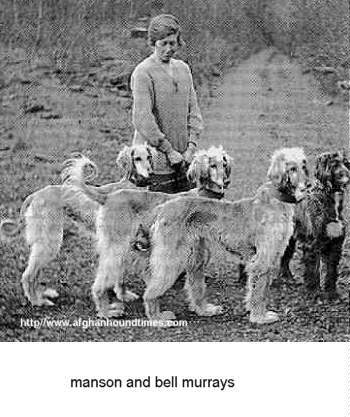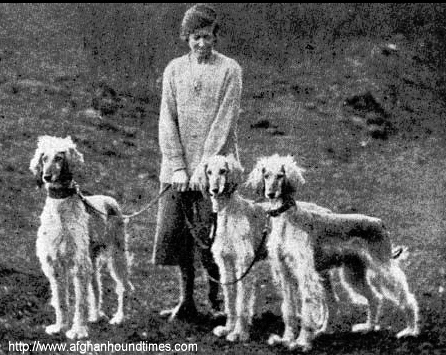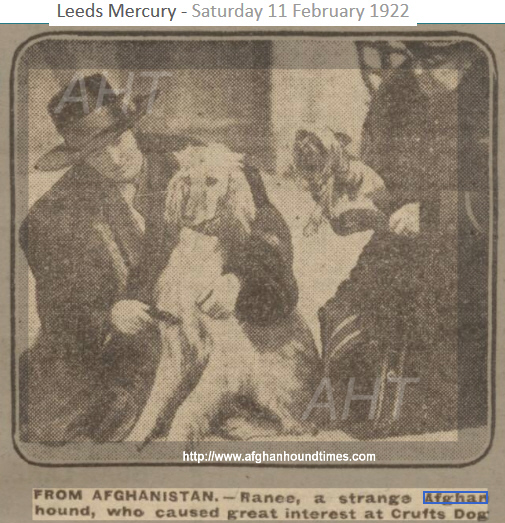(Afghan Hound Database and Breed Information Exchange)
Author Miss Jean C. Manson (Cove Afghan Hounds) Published in American Kennel Gazette, June 1, 1929
Editors Note: This article, and another early article by Evelyn Denyer published in 1925 have been referenced by our Breed Book Authors who have, quite reasonably, extracted segments of the original article for inclusion for reference and discussion in their books. Here below we publish the FULL article, and CONTEXT in which is was written I followed up with a "critique", (see the Origins section) attempting to point out the context of the article, and that its purpose was not to give us a history of the breed per se, rather, it was a marketing statement, intended to promote the Afghan Hound in its founding days in the West and help the new breed gain acceptance. At the end of this article we add some notes by Connie Miller and as published by Gazehound Magazine in 1979. Author Miss Jean C. Manson (Cove Afghan Hounds) Published in American Kennel Gazette, June 1, 1929 I think it was their extraordinary graceful movements and wonderful expression which attracted me to the breed when I first saw an Afghan Hound. Though I had lived on the borders of Baluchistan for some time, I had never seen one, and it was one day while out riding about twenty miles from Quetta, that I first saw one of those beautiful animals. Her owner was riding also, and what held me spellbound was the beautiful movement and grace of the dog.
I followed and eventually caught up with them. After a great deal of persuasion and talk, I got her native owner to understand that I wanted his dog. But he did not want to part with her. However, after many promises, at last he said he would bring her to m y bungalow the following day. And so I got my first Afghan Hound. I named her Begum, which means Queen. No other name could have suited her. She certainly was the most beautiful animal I had ever seen - white in color, with large brown eyes, a perfect body and carriage. She took possession of our home we all felt we had to wait on her. Cat-like, she did not like getting her feet wet and she always insisted on the most comfortable chair and a cushion. In spite of these indoor manners, when out with us, there was nothing she would not jump or swim. Her courage was marvelous, and nothing gave her greater pleasure than to be with us. If she knew we were going riding then Begum took up her position in front of the horses, and enjoyed every moment of a hard gallop, coming back fresher than either horse or rider. It was the same when going out driving, and it was on one of these occasions while driving in the native bazaar, after I had owned Begum for more than two years, that she saw her original master amongst the natives. She jumped out of the trap and greeted him with many whines of joy. During this long time I had been making every endeavor to get a suitable mate for Begum. It was nearly four years before I was successful. Finally, through one of the many natives I had engaged to search for typical specimens, I got what I wanted. The dog I called Rajah. These two were my original Afghans. Eventually a family of young Afghans arrived, and Begum was a most wonderful mother. For days before her family was born she collected food and hid it in a cave or little dell in the garden, where she intended to have her puppies. When they were old enough to run abut and, in fact, when they were quite big she carried food to them. Also she washed and took care of them long after they were weaned. The puppies also greeted her with great joy.
From about three months of age the Afghan puppy is a most wonderful youngster, all legs and the most lovely soft fur, more like down, and all eyes, just like teddy bears. From babyhood they are most wonderfully gentle, never snatching food, and in every way they are most lovable. They make charming pets and are so distinguished looking, stately and graceful that the most fastidious fancier would consider them an ornamental asset. There is something so foreign about his appearance - something perhaps a little outlandish - that the dog brings to mind the splendor of the mysterious East. Instinctively one associates him with Eastern magnificence, stately palaces, gardens and courtyards, and native attendants to grant their wishes. In spite of this aristocratic appearance and look of reserve, these dogs are the very reverse of unapproachable, and are, indeed more docile and affectionate. And a kind word and pat is never forgotten. But a rebuff will be taken to heart with great distress. An Afghan does not know what a whip is. Their courage and staying powers are wonderful They invariably hunt in couples, the bitch taking the hinder part and the dog the throat. They have been known to kill a leopard and I myself, have seen a couple give chase to a pack of jackals and have seen Rajah, my own Afghan, kill a fox and a deer in the mountains at Quetta. In fact, so famous was Rajah that he was repeatedly stolen from me by the natives. Once he returned home, after an absence of two months, pained red and hanging in chains and ropes. No doubt, his captor thought if he were painted I should not recognize him. But Rajah came home himself. In 1921 I sailed for England bringing with me twelve of these hounds, unrelated and with these I founded the first English Afghan Hound kennel, although in 1906 Mr. Barff brought and Afghan Hound to England that caused such a sensation that the King and Queen expressed a desire to see it. It was dispatched to Buckingham Palace under the charge of Mr. Sewell, M.R.C.V.S. The Afghan to-day is in great demand in the British Isles. At Crufts and all the other big shows in England the general cry is "where are the Afghans benched?" His trousered legs and topknot seem to cause a sensation wherever he goes. At the Cove Kennels, Kirkpatrick, Fleming Scotland, there can be seen Afghans of all ages, from graceful, full-grown to wooly babies, and along our quiet roads in Scotland, where they are seen walking every day, they still cause excitement. Buckmall, a very typical hound at the Cove kennels, seems to understand everything, and watches very quietly what is going on around him. If he is tired of being in the paddock, he just opens the gate with his nose, walks to the kennel, opens the big kennel door with his teeth and paw, then finds his own house, opens the doors and goes in. At feeding time, after he has eaten his food, if he feels he could eat more, he hides his plate under his bed and, naturally at first, when he saw no plate, he was fed again, until the next morning the plates were discovered, and after that all were told to look under his bed before feeding. Some people say the Afghan is more bizarre than beautiful, but in either category can be found the key to popularity. Not with the masses, for so scarce is this wonderful dog that one instantly places him among the museum curiosities and art objects. Not a made dog but one of the oldest and purest of breeds. Faithful and intelligent and most remarkable for their memory of faces and voices. A club has been formed to guard the interests of this breed, and Mr. Barff's famous dog, Zardin has been fixed as our standard. He was the dog which made his bow at Buckingham Palace in 1906. Some time ago, Evelyn Denyer, honorable secretary of our club, wrote some interesting lines about the breed. These lines are worth reprinting, they follow: "The most attractive feature of the Afghan Hound seems to be his trousers and his topcoat, chiefly because they are distinctive. This extract from one of the English papers is rather amusing; "The Afghan Hounds are whimsical fellows when in full coat with their Oxford bags, top-knot, and tufts. They recall the lines of Oliver Wendell Holmes: I know it is a sin For me to sit and grin At him here: But the old three-cornered hat And the breeches and all that Are so queer!" It is a great pity that there is this conviction, that because they are Orientals they are delicate. Few people realize that in Afghanistan they experience far more extremes of heat and cold than either England or America has. On the other hand, however, the climate is dry. In England, no more precautions against our really deplorable climate are necessary than making sure that their kennels and bedding are not damp; not allowing them to be shut up with wet coats, if they have been out in the rain; and on wet days keeping them under cover. In fact, one should do no less than this for any dog. "Puppies are born and reared in outside kennels with no special heating, even in the depth of winter, and when old enough they spend the day out-of-doors in an open run, no matter how low the thermometer. When puppies are growing up, say from eight weeks to five months and perhaps more, their knee joints are very prominent and this is so noticeable that many people have insisted that they have rheumatism. This condition is normal; desirable, in fact. "One American recently asked whether they would be successful as coon dogs, and as an English owner I must admit ignorance as to what is require of a coon dog. The Afghan hunts almost entirely by sight and his powers in this direction are marvelous. His nose is quite useful, too, on occasion.
Another thing "outsiders" do not realize, and that is the Afghan's enormous strength and power. This is due to their graceful outline and rather chiseled appearance and elegance. A hound which is well developed should possess hard muscle and a great deal of it should be in the hindquarters; but should slope well into the long, strong neck. Bone should be heavy and the feet as large as possible, all joints, very flexible, and the greater depth of brisket the better, with a neat tuck-up under the loins. "The great thing in breeding is to keep this strength, muscle and bone without producing coarseness. Thick heavy shoulders, thick loins and a wide chest etc, give a general appearance of cumbersomeness. A hound of this variety might be heavy and strong, but his lack of agility would be far too great a handicap to him, apart from his unattractive appearance" "On the other hand, weedy, light boned hounds are not coveted, however pretty and graceful they may be. It has to be remembered that they are sporting dogs, not drawing-room pets. Their forefathers have done rough work, and it will be a thousand pities if we allow them to degenerate into ornaments. Some Afghan stock is now in the United States, and I feel perfectly sure that the breed is going to be exceedingly popular on the other side of the Atlantic. When I recently visited America the animals were exceedingly well received. People would stand and stare and say, "Isn't he cute" Just why an Afghan should be called "cute" I do not know. But I do know that the breed is in the United States to stay. American Kennel Gazette, June 1, 1929
Excerpts from "The Search For Truth In Gazehounds - Conni Miller c 1979 The Afghan Hound re-emerged in 1921, in Scotland with the arrival of twelve hounds owned by Major and Mrs. Bell-Murray and/or Miss Jean Manson, who I was variously told was Mrs. Bell Murray's sister, her cousin, his cousin, or less innocently connected to the Major. A first mention appearing in The Scottish Field written by Will Hally in 1921 does not include Miss Manson's name. The lengthy article explains - "it was in 1913 when out riding near Quetta in Baluchistan, that Major Bell-Murray saw an Afghan with a dog which he thought the most perfect animal he had ever seen. After much bargaining, he succeeded in buying the bitch from its Afghan owner, and it is she, named Begum which means Queen, who has been the foundation of the stud which is now established near Dalbeattie. Jean Manson penned this now famous article, "The Dog Of The Mystic East" for the June 1929 issue of the AKC Gazette, with word for word paraphrasing exactly the same story - but differing in that she declared herself to have been out riding near Quetta etc..." With no mention of the Bell-Murrays (nor Will Hally). Such self-serving plagiarisms casts doubt on the veracity of all statements and persons involved. It has been suggested that the Bell-Murrays were intermittently recalled to India, and appointed Miss Manson as their agent, which might be the strange truth of it. A 1923 ad has the dogs as "Bell-Murrays Afghan Hounds, at The Cove in Dumfrieshire". By 1925 they had become "Jean Manson's world-famous Afghan Hounds" - still at the "Cove". Related content: Major Graham Bell Murray 1881-1955 by Lyall Payne, 2014 12/15/11 Article "Mysterious Bell-Murray/Cove photo" Steve Tillotson December 2011 "The Afghan Hound Is An Ancient Breed" - Evelyn Denyer, 1925 Early Afghan Hounds Hyland Afghan Painting Breed history in Peru (Kasi Of Cove) (by Steve Tillotson, December 2015) |





